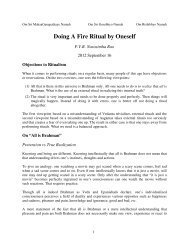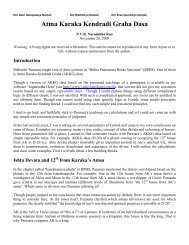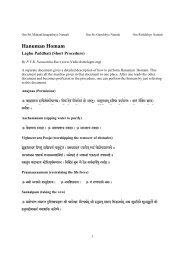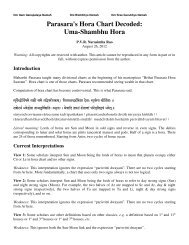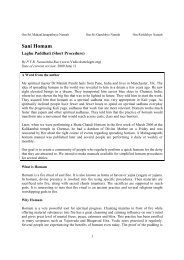The Glory of the Goddess-Devi Mahatmyam
The Glory of the Goddess-Devi Mahatmyam
The Glory of the Goddess-Devi Mahatmyam
Create successful ePaper yourself
Turn your PDF publications into a flip-book with our unique Google optimized e-Paper software.
<strong>The</strong> vanquished gods collectively surrendering to <strong>the</strong> <strong>Devi</strong><br />
<strong>The</strong> gods first approach Brahma who leads <strong>the</strong>m to Vishnu and Shiva. <strong>The</strong>re is a significance<br />
in <strong>the</strong> gods first approaching Brahma. As per Hindu mythology Brahma was born from a<br />
lotus that grew at Lord Vishnu’s navel. Here Vishnu signifies Consciousness while <strong>the</strong> lotus<br />
signifies flowering or blossoming <strong>of</strong> Consciousness. Brahma being born from <strong>the</strong> nabhikamala<br />
(navel chakra) <strong>of</strong> Vishnu is clearly a Puranic allusion to Kundalini and <strong>the</strong> Chakras.<br />
<strong>The</strong> nabhi is <strong>the</strong> vedic equivalent to what is known as known as <strong>the</strong> Manipura chakra in <strong>the</strong><br />
tantric system. Below <strong>the</strong> manipura chakra is asura kshetra (field <strong>of</strong> demoniac<br />
consciousness), while daiva kshetra (field <strong>of</strong> divine consciousness) starts from manipura.<br />
Thus <strong>the</strong> very awareness <strong>of</strong> <strong>the</strong> conflict between <strong>the</strong> righteous and unrighteous samskaras and<br />
<strong>the</strong> need to overcome asuric samskaras, starts with <strong>the</strong> manipura. Now that spiritual<br />
awareness has started blossoming it will lead to <strong>the</strong> coming toge<strong>the</strong>r <strong>of</strong> all <strong>the</strong> spiritual<br />
samskaras, <strong>the</strong> coming toge<strong>the</strong>r <strong>of</strong> <strong>the</strong> powers <strong>of</strong> <strong>the</strong> gods. Brahma leads <strong>the</strong> gods to Vishnu<br />
and Shiva. Vishnu and Shiva too symbolise specific psychological functions like <strong>the</strong> o<strong>the</strong>r<br />
gods. In <strong>the</strong> symbolism <strong>of</strong> <strong>Devi</strong> <strong>Mahatmyam</strong>, <strong>the</strong> <strong>Devi</strong> is obviously <strong>the</strong> Supreme Being or<br />
Supreme Self, whereas Vishnu and Shiva symbolise prana shakti and gnana shakti<br />
respectively.<br />
What happens when all <strong>the</strong> powers <strong>of</strong> all <strong>the</strong> gods come toge<strong>the</strong>r? As <strong>the</strong> <strong>Devi</strong> <strong>Mahatmyam</strong><br />
reveals, all <strong>the</strong> radiance from all <strong>the</strong> gods coalesced into <strong>the</strong> auspicious form <strong>of</strong> <strong>the</strong> <strong>Goddess</strong>.<br />
<strong>The</strong> tejas that emerges from <strong>the</strong> gods is not <strong>the</strong>ir creation but <strong>the</strong> <strong>Devi</strong>’s natural indwelling<br />
presence. Thus what coalesces into <strong>the</strong> <strong>Devi</strong>’s auspicious form is actually Her own power.<br />
<strong>The</strong> gods do not relinquish <strong>the</strong>ir power or weapons, even as <strong>the</strong>ir varied powers reunite in <strong>the</strong><br />
<strong>Devi</strong>. This is a sublime philosophical abstraction <strong>of</strong> simultaneous divine immanence and<br />
transcendence. Now that <strong>the</strong> collective power <strong>of</strong> <strong>the</strong> gods is united against Mahishasura and<br />
his armies, <strong>the</strong> gods can be assured <strong>of</strong> <strong>the</strong>ir inevitable victory.<br />
Mahishasura and his Generals- Rajo-guna and its Asura sampada<br />
Mahishasura symbolises <strong>the</strong> powerful combination <strong>of</strong> human competence and beastly nature.<br />
As already stated he stands for Rajo-guna. While Kaitabha is also rajas, he comes as a twin <strong>of</strong><br />
Madhu (tamas), at <strong>the</strong> level <strong>of</strong> origination. Unlike Kaitabha who is <strong>of</strong> <strong>the</strong> nature <strong>of</strong> rajas,<br />
Mahishasura is <strong>the</strong> epitome <strong>of</strong> Rajo-guna. He has sixteen asuras who lead various battalions<br />
<strong>of</strong> armies. <strong>The</strong>y stand for various demoniac traits or tendencies and are Mahishasura’s assets<br />
or wealth. Toge<strong>the</strong>r <strong>the</strong>y are all asura sampada or demoniac wealth or assets (see <strong>the</strong> chapter<br />
on Daiva sampada and Asura sampada for more).<br />
If Mahishasura has to be subdued his generals have to be eliminated first, his demoniac<br />
wealth has to be destroyed first. But <strong>the</strong> asura armies vastly outnumber <strong>the</strong> gods.<br />
Commenting on <strong>the</strong> Brhadaranyaka Upanishad’s (1, 3) account <strong>of</strong> a similar conflict between<br />
<strong>the</strong> gods and <strong>the</strong> demons Adi Shankara tells us that <strong>the</strong> gods are always less in number while<br />
<strong>the</strong> demons are more. So what to do? <strong>The</strong>re is only one way out- absolute surrender to <strong>the</strong><br />
Supreme <strong>Goddess</strong>. Nothing less than total surrender will bail <strong>the</strong>m out <strong>of</strong> <strong>the</strong>ir difficulty. And<br />
this is precisely what <strong>the</strong> gods do.<br />
34



